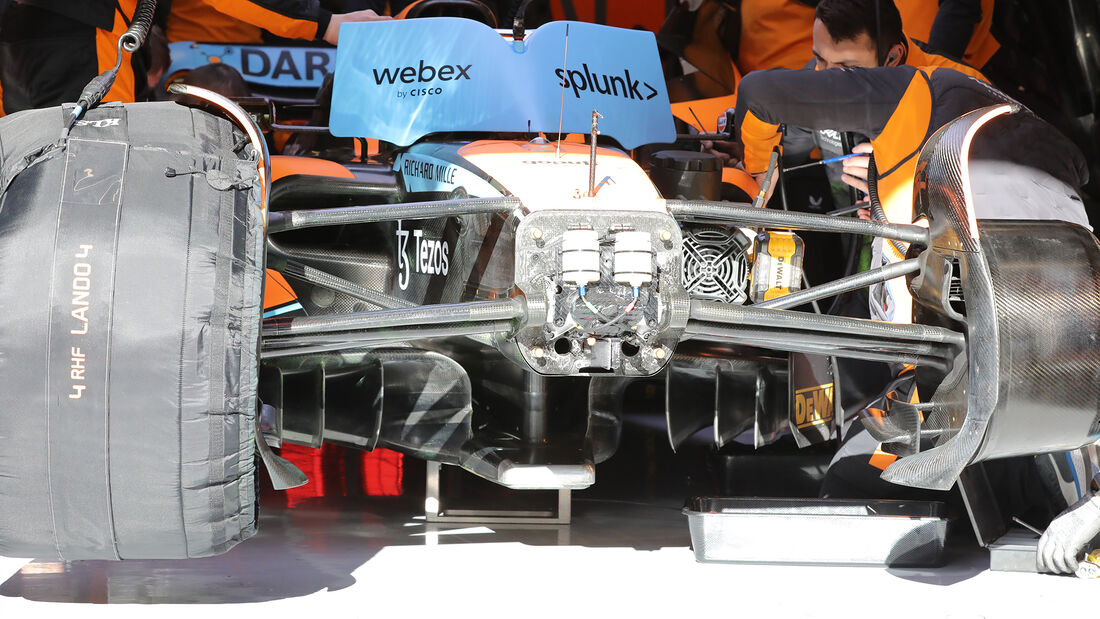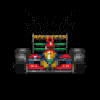- Login or Register
No account yet? Sign up
isn't that a problem on the track too? look at black marks on the track... it seems to be a bit bumpy.
Merc was reported to suffer from severe porpoising.godlameroso wrote: ↑24 Feb 2022, 19:35I'm starting to suspect the porpoising is due to their bow, both Aston and Ferrari have similar bows, with the fillet winglet on the sides.
timbo wrote: ↑24 Feb 2022, 20:35Merc was reported to suffer from severe porpoising.godlameroso wrote: ↑24 Feb 2022, 19:35I'm starting to suspect the porpoising is due to their bow, both Aston and Ferrari have similar bows, with the fillet winglet on the sides.


But is it really driven by the instability on the front? It may also be a choking diffuser in the rear.godlameroso wrote: ↑24 Feb 2022, 21:05Severe separation in their bow, very detached flow, wouldn't surprise me to see that instability propagate down the floor.
They were studying the underside of the front wing, this is just overspraygodlameroso wrote: ↑24 Feb 2022, 21:05https://cdn-1.motorsport.com/images/mgl ... -w13-1.jpgtimbo wrote: ↑24 Feb 2022, 20:35Merc was reported to suffer from severe porpoising.godlameroso wrote: ↑24 Feb 2022, 19:35I'm starting to suspect the porpoising is due to their bow, both Aston and Ferrari have similar bows, with the fillet winglet on the sides.
Severe separation in their bow, very detached flow, wouldn't surprise me to see that instability propagate down the floor.
Aerodynamically speaking, choking means no more flow than what has been achieved, it doesn't mean flow stops. If choking happens it is either the throat or the inlet near the strake and bow. Those are the only places the flow can "choke" in the aerodynamic sense. Stalling is caused by flow separation and the resulting turbulence restoring atmospheric pressure.timbo wrote: ↑24 Feb 2022, 21:15But is it really driven by the instability on the front? It may also be a choking diffuser in the rear.godlameroso wrote: ↑24 Feb 2022, 21:05Severe separation in their bow, very detached flow, wouldn't surprise me to see that instability propagate down the floor.
Ok.mantikos wrote: ↑24 Feb 2022, 21:21They were studying the underside of the front wing, this is just overspraygodlameroso wrote: ↑24 Feb 2022, 21:05https://cdn-1.motorsport.com/images/mgl ... -w13-1.jpg
Severe separation in their bow, very detached flow, wouldn't surprise me to see that instability propagate down the floor.

Is it possible to break up strong vortices if they are compressed into the floor?godlameroso wrote: ↑24 Feb 2022, 21:22Aerodynamically speaking, choking means no more flow than what has been achieved, it doesn't mean flow stops. If choking happens it is either the throat or the inlet near the strake and bow. Those are the only places the flow can "choke" in the aerodynamic sense. Stalling is caused by flow separation and the resulting turbulence restoring atmospheric pressure.timbo wrote: ↑24 Feb 2022, 21:15But is it really driven by the instability on the front? It may also be a choking diffuser in the rear.godlameroso wrote: ↑24 Feb 2022, 21:05Severe separation in their bow, very detached flow, wouldn't surprise me to see that instability propagate down the floor.
The bow can certainly contribute to this instability because the strake the road and the bow form a duct.
Strong vortices break up on their own if the pressure differential is disturbed. Strong vortices need strong energy to create and propagate them. Smaller vortices require less energy to create and maintain.SiLo wrote: ↑24 Feb 2022, 21:31Is it possible to break up strong vortices if they are compressed into the floor?godlameroso wrote: ↑24 Feb 2022, 21:22Aerodynamically speaking, choking means no more flow than what has been achieved, it doesn't mean flow stops. If choking happens it is either the throat or the inlet near the strake and bow. Those are the only places the flow can "choke" in the aerodynamic sense. Stalling is caused by flow separation and the resulting turbulence restoring atmospheric pressure.
The bow can certainly contribute to this instability because the strake the road and the bow form a duct.

I assume as long as those smaller vortices are not forming to create a bigger one right?godlameroso wrote: ↑24 Feb 2022, 21:32Strong vortices break up on their own if the pressure differential is disturbed. Strong vortices need strong energy to create and propagate them. Smaller vortices require less energy to create and maintain.SiLo wrote: ↑24 Feb 2022, 21:31Is it possible to break up strong vortices if they are compressed into the floor?godlameroso wrote: ↑24 Feb 2022, 21:22
Aerodynamically speaking, choking means no more flow than what has been achieved, it doesn't mean flow stops. If choking happens it is either the throat or the inlet near the strake and bow. Those are the only places the flow can "choke" in the aerodynamic sense. Stalling is caused by flow separation and the resulting turbulence restoring atmospheric pressure.
The bow can certainly contribute to this instability because the strake the road and the bow form a duct.
Depends, it takes energy to create a vortex, there's no such thing as a free lunch, even if you're a good looking woman. If those smaller vortices helically braid each other they will eventually merge as long as the energy stream isn't interrupted. IE not too much flow separation/cross winds/turbulence.SiLo wrote: ↑24 Feb 2022, 21:35I assume as long as those smaller vortices are not forming to create a bigger one right?godlameroso wrote: ↑24 Feb 2022, 21:32Strong vortices break up on their own if the pressure differential is disturbed. Strong vortices need strong energy to create and propagate them. Smaller vortices require less energy to create and maintain.
Well, of course, the surface which first meets the stream can contribute to what's happening downstream.godlameroso wrote: ↑24 Feb 2022, 21:22Aerodynamically speaking, choking means no more flow than what has been achieved, it doesn't mean flow stops. If choking happens it is either the throat or the inlet near the strake and bow. Those are the only places the flow can "choke" in the aerodynamic sense. Stalling is caused by flow separation and the resulting turbulence restoring atmospheric pressure.timbo wrote: ↑24 Feb 2022, 21:15But is it really driven by the instability on the front? It may also be a choking diffuser in the rear.godlameroso wrote: ↑24 Feb 2022, 21:05Severe separation in their bow, very detached flow, wouldn't surprise me to see that instability propagate down the floor.
The bow can certainly contribute to this instability because the strake the road and the bow form a duct.
My bad, I mistook it for a wrong winglet.godlameroso wrote: ↑24 Feb 2022, 19:46The plank area is still flat and can easily stall. If it does it will create turbulence and high pressure which has nowhere to go but the tunnels.ryaan2904 wrote: ↑24 Feb 2022, 19:43Idk, I've been following closely and ferrari didn't seem to be having the problem yesterday and most of today. Only after lec made some suspension change did it become so apparent.godlameroso wrote: ↑24 Feb 2022, 19:35I'm starting to suspect the porpoising is due to their bow, both Aston and Ferrari have similar bows, with the fillet winglet on the sides.
Like the song goes, rock-a-by baby, on the tree top, when the bow breaks, the cradle will rock.
https://i.imgur.com/f14vfXG.png
I believe the vortex shed by that winglet is breaking up and it has a cascade effect downstream.
Other teams with more bluff areas there seem to deal with it better.
Also, Imo it's more to do with aero stall rather than some aero problem.
Could be! But that's easy to tune out with bump stops.timbo wrote: ↑24 Feb 2022, 21:44Well, of course, the surface which first meets the stream can contribute to what's happening downstream.godlameroso wrote: ↑24 Feb 2022, 21:22Aerodynamically speaking, choking means no more flow than what has been achieved, it doesn't mean flow stops. If choking happens it is either the throat or the inlet near the strake and bow. Those are the only places the flow can "choke" in the aerodynamic sense. Stalling is caused by flow separation and the resulting turbulence restoring atmospheric pressure.
The bow can certainly contribute to this instability because the strake the road and the bow form a duct.
What I noticed is that in that video (with Leclerc) the car seemed to also change the pitch, so first, the rear dropped, then the car bounces back. So I think it was rear ride height which was critical.
I guess maybe they were experimenting with the rear drop trick, which was made famous by Merc last year, but Ferrari also did it. With the new aero formula, the car may not like it so much.